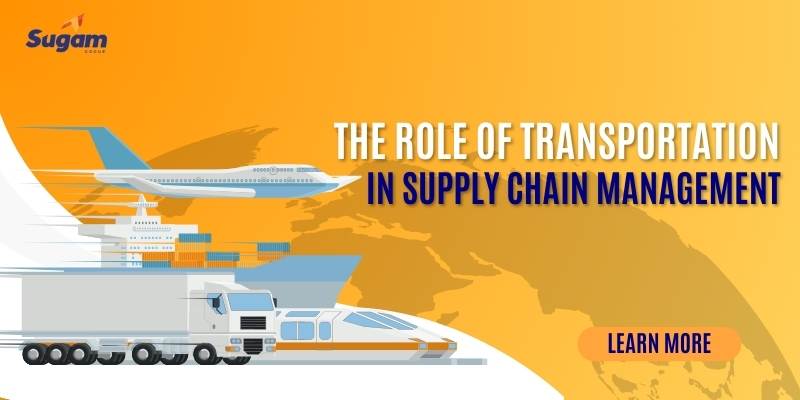The Role of Transportation in Supply Chain Management
In the complex and dynamic world of supply chain management, efficient and strategic transportation plays a pivotal role in ensuring the seamless flow of goods from manufacturers to end consumers. Sugam Group, a key player in the industry, understands the significance of transportation in enhancing its supply chain processes. In this blog, we delve into the critical role transportation plays in supply chain management, emphasising how Sugam Group leverages this aspect to optimise its operations.
The Role of Transportation in Supply Chain Management
Supply Chain Management is the practice of organising the secure flow of goods and services. Depending on the industry this can vary from the product offered by the specific industry. The process includes and considers the entire conversion of raw material into finished products, and then reaching the hands of the end customer.
The management part of this process is where it gets interesting. It is required by managers to minimise the effort and resources that it takes to make the supply chain more economical. Streamlining this process to gain a competitive advantage and making happy customers is what SCM is all about.
SCM includes everything from the production of products to the development of information systems to keep track of everything. The chain has 3 main components from start to finish which simplifies the process a little. These components are Purchasing, Manufacturing, and most importantly Transportation.
Having a clear and economical transportation strategy is absolutely vital to grow your business. It involves creating a wide web of seamless distribution and sorted-out transportation plans for both receiving and shipping products. A good shipping flow is what keeps your customers coming back for more business because nobody likes to receive late orders.
Also Read:- Role Of Logistics Companies In The Growth Of The Indian Economy
The Role Of Warehousing In Supply Chain Management
The Three Components of Supply Chain Management
Within the intricate web of supply chain management, three core components stand as the pillars orchestrating the seamless flow of goods: purchasing, manufacturing, and transportation. These components collectively navigate the journey of raw materials to the hands of the end customer, requiring a series of critical decisions to be made at each juncture.
1. Purchasing: The Foundation of Supply Chain
Purchasing lays the groundwork for the entire supply chain, involving crucial decisions about the materials used in the production process. From selecting suppliers to negotiating contracts, strategic purchasing sets the tone for product quality, cost efficiency, and overall supply chain reliability. This initial phase shapes the subsequent stages, emphasising the importance of making informed decisions regarding suppliers and the materials they provide.
2. Manufacturing: Crafting Efficiency and Precision
Once the materials are secured, the manufacturing component takes centre stage. Decisions in this phase range from determining production amounts to managing inventory levels. Striking the right balance is key – producing enough to meet demand without overburdening the inventory. Efficient manufacturing not only ensures product availability but also contributes to cost-effectiveness and streamlined operations throughout the supply chain.
3. Transportation: The Backbone of Supply Chain Dynamics
Arguably the linchpin of supply chain management, transportation encompasses decisions that extend from the sourcing of materials to the delivery of finished products. Crafting an effective transportation strategy involves configuring the distribution network, considering both inbound and outbound logistics. From selecting carriers to optimising shipping routes, every decision impacts the timely and cost-efficient movement of goods. It’s in this phase that effective transportation management often becomes the competitive differentiator for a company.
How Transportation Works in Supply Chain Management
The modes of transportation—be it road, air, sea, or rail—each have unique advantages and applications in the supply chain. Sugam Group, recognizing the diversity of transportation options, strategically selects the most suitable modes for different scenarios. For instance, time-sensitive deliveries might benefit from air transport, while bulk shipments might be more cost-effectively handled via sea or rail.
Moreover, Sugam Group embraces technological advancements in transportation. The integration of GPS tracking, real-time data analytics, and automation enhances visibility, allowing for better decision-making and increased responsiveness to changes in the supply chain. This technological edge empowers Sugam Group to stay ahead in the competitive landscape.
Supply Chain Transportation Risks to Consider
Transportation, while essential, comes with inherent risks. Delays, damages, and disruptions can occur due to various factors such as weather, accidents, or geopolitical events. Sugam Group acknowledges these risks and has implemented robust risk management strategies.
By thoroughly assessing potential risks, the group can develop contingency plans and build flexibility into its transportation strategies. This proactive approach not only mitigates potential disruptions but also ensures a resilient supply chain capable of adapting to unforeseen challenges.
Future Trends in Supply Chain Transportation
As technology continues to evolve, the landscape of supply chain transportation is transforming rapidly. Sugam Group, with its forward-thinking approach, keeps a keen eye on emerging trends. The integration of artificial intelligence, blockchain, and sustainable practices is shaping the future of transportation.
Sugam Group recognizes the need to stay agile and adaptive in the face of these changes. By embracing innovation and staying informed about industry trends, the group positions itself as a leader in the ever-evolving supply chain ecosystem.
Conclusion
In conclusion, transportation is not merely a logistical function for Sugam Group; it is a strategic imperative that contributes significantly to the group’s success in supply chain management. By understanding the interconnected components of supply chain management, leveraging technology, addressing risks, and staying ahead of emerging trends, Sugam Group exemplifies how a holistic approach to transportation can unlock operational excellence and customer satisfaction.
As businesses navigate the complexities of the modern supply chain, Sugam Group stands as a beacon, showcasing the transformative power of effective transportation management. By recognizing transportation as a cornerstone of success, Sugam Group continues to shape the future of supply chain management and set new standards for the industry.




No Comments